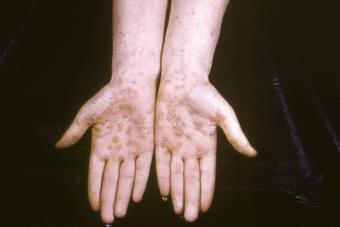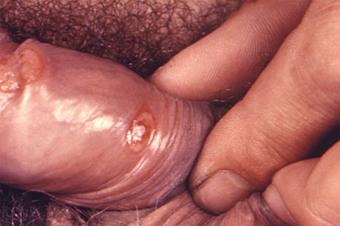
A skin rash can be a sign of secondary syphilis and means the disease has progressed from the primary stage. Treatment is important in these two early phases of syphilis before it reaches the later latent or tertiary stages. Once this sexually transmitted infection (STI) progresses to tertiary syphilis, it can affect multiple organs, cause severe symptoms, and lead to death.
Syphilis Rash: A Sign Not to be Ignored
Syphilis is highly contagious and is often not diagnosed until the secondary stage. The rash is the most common of the signs and symptoms of this stage and, according to MedlinePlus, characteristics of the rash include the following:
- It typically appears toward the end of the primary stage or four to eight weeks later.
- It presents as red or reddish-brown spots on the skin, which are rarely itchy.
- The rash can occur on various parts of the body - sometimes occurring in more than one area.
- Typical sites include the palms of the hands or soles of the feet.
- As the infection progresses, the rash can be present in moist areas of the body such as the arm-pits, groins, and under the breasts of women.
- In some cases the rash might be so faint that it is barely noticeable.
Even without treatment for syphilis, the rash can disappear in three to six weeks but the disease can go on to the later stages. It is crucial that the rash of secondary syphilis is not ignored or mistaken for other skin conditions.
Diagnosing Syphilis

According to recent statistics from the Centers for Disease for Disease Control and Prevention (CDC), syphilis is most common in young men ages 20 to 29. The rates of primary and secondary syphilis increased in men and women from 2013 to 2015. The four stages of the disease are primary, secondary, latent, and tertiary, each stage having its specific characteristics.
Other Symptoms of Secondary Syphilis
To extend on the rash described above, secondary syphilis also presents with other symptoms which can lead a person to seek medical attention and a diagnosis early. According to a CDC Fact Sheet, all or some of the following symptoms may be present in an individual and some can persist for several weeks:
- Mucous membrane sores - typically in the mouth, vagina, and anus
- Swollen lymph glands - which are often painful
- Fever - sometimes accompanied by sweating
- General lethargy and fatigue - the individual will have no energy or drive to go about daily activities
- Headaches - for those who don't normally suffer headaches these will be prominent
- Aching limbs - particularly with movement; activities feel like a major effort
- Scalp hair loss - which is usually patchy
- Unexplained weight loss - that is, not caused by change in diet or exercise
To help confirm the diagnosis of syphilis during the secondary or any other stage, a blood test is done to detect anti-syphilis antibodies. The sooner a person seeks medical attention, the quicker treatment can start to avoid the later stages of syphilis.
Primary Syphilis

In the primary or first stage of syphilis, according to the Mayo Clinic, the affected person develops one or more ulcerated lesion at the site(s) of infection, known as a "chancre":
- Common sites for a chancre include the genitals, the anus, and the mouth.
- A chancre sore is usually round and hard and is painless.
- It might not appear until two to three weeks after the initial infection and can persist from three to six weeks.
- The sore might resolve without any treatment so it is important to seek early medical care and treatment for any sores you notice in the common sites of infection.
- Doctors usually swab and culture the chancre to identify the syphilis bacteria (treponema pallidum).
Recognition and adequate treatment of syphilis at the primary stage will cure the disease and prevent progression to the secondary or later stages. Most often, women are diagnosed at this stage by their gynecologist and men by their primary care doctor.
Latent and Tertiary Syphilis

The last two stages of syphilis are markedly different from each other and earlier stages. The CDC Fact Sheet, cited above under the Secondary Syphilis subsection, notes the following about the two stages:
- Latent Stage: A person who has progressed to latent syphilis because of lack of or inadequate treatment usually has no signs or symptoms of the disease. When unrecognized and untreated latent syphilis can persist for years.
- Tertiary Stage: Many untreated people infected with syphilis stay in the latent phase and do not progress to the tertiary stage. Those who do can have severe damage to several organs including the heart, blood vessels, eyes, brain, and nervous system (neurosyphilis). Because of this damage, tertiary syphilis can lead to difficulty with movement, paralysis, dementia, and death.
Note, sometimes a person might be diagnosed at the latent stage because they happen to get a syphilis blood test done, for example for a marriage license.
Syphilis in Pregnancy
Syphilis is known to be dangerous in pregnancy. The bacteria treponema pallidum can pass easily from mother to fetus and newborn. It can lead to:
- Low birth weight
- Stillbirth or newborn infant death
- Congenital syphilis with serious problems such as cataract and deafness later in childhood if the child is not treated
Fortunately routine early prenatal lab work includes a screening for syphilis. The mother can be treated during her pregnancy if screening and confirmation tests are positive.
Treatment for Syphilis
The usual treatment of primary, secondary, latent, and tertiary syphilis is by injection of penicillin into a muscle. Alternate antibiotics are used if a person is allergic to penicillin. Treatment details are summarized on page 20 of the World Health Organization treatment guidelines. It is important to note:
- If detected and treated in the early stages, the bacterial infection can be cured before the disease progresses. However, treatment will not improve the damages of tertiary syphilis.
- The additional symptoms of secondary syphilis, such as fever, fatigue, and enlarged glands will resolve with antibiotics treatment.
- Analgesics such as Tylenol can be added to ease muscle aches and other general discomforts.
Treatment of the Rash of Secondary Syphilis
The rash of secondary syphilis does not require any specific treatment because it does not usually cause any symptoms such as itching. The rash will resolve on its own with or without treatment. Moisturizing the skin can improve comfort if dryness is a problem.
Prevention First
As with any other sexually transmitted infection, prevention is the key to avoid being infected with syphilis. Avoid unprotected sex with multiple partners. Insist on the use of condoms with every sexual partner. In a monogamous relationship, to decrease the risk for you and your partner, you should both be tested for syphilis and other STIs before engaging in unprotected sex.







